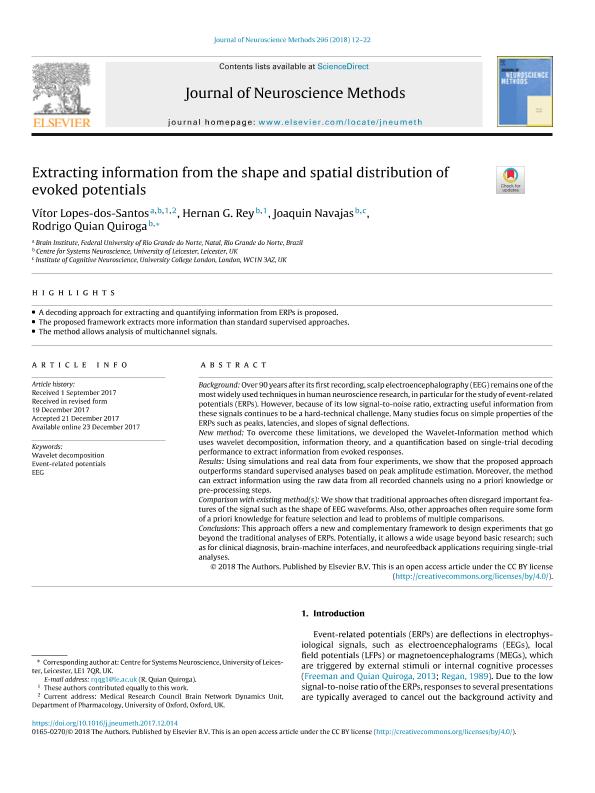Mostrar el registro sencillo del ítem
dc.contributor.author
Lopes-dos-Santos, Vítor
dc.contributor.author
Rey, Hernan G.
dc.contributor.author
Navajas Ahumada, Joaquin Mariano

dc.contributor.author
Quian Quiroga, Rodrigo

dc.date.available
2020-02-26T19:01:28Z
dc.date.issued
2018-02-15
dc.identifier.citation
Lopes-dos-Santos, Vítor; Rey, Hernan G.; Navajas Ahumada, Joaquin Mariano; Quian Quiroga, Rodrigo; Extracting information from the shape and spatial distribution of evoked potentials; Elsevier Science; Journal of Neuroscience Methods; 296; 15-2-2018; 12-22
dc.identifier.issn
0165-0270
dc.identifier.uri
http://hdl.handle.net/11336/98460
dc.description.abstract
Background Over 90 years after its first recording, scalp electroencephalography (EEG) remains one of the most widely used techniques in human neuroscience research, in particular for the study of event-related potentials (ERPs). However, because of its low signal-to-noise ratio, extracting useful information from these signals continues to be a hard-technical challenge. Many studies focus on simple properties of the ERPs such as peaks, latencies, and slopes of signal deflections. New method To overcome these limitations, we developed the Wavelet-Information method which uses wavelet decomposition, information theory, and a quantification based on single-trial decoding performance to extract information from evoked responses. Results Using simulations and real data from four experiments, we show that the proposed approach outperforms standard supervised analyses based on peak amplitude estimation. Moreover, the method can extract information using the raw data from all recorded channels using no a priori knowledge or pre-processing steps. Comparison with existing method(s) We show that traditional approaches often disregard important features of the signal such as the shape of EEG waveforms. Also, other approaches often require some form of a priori knowledge for feature selection and lead to problems of multiple comparisons. Conclusions This approach offers a new and complementary framework to design experiments that go beyond the traditional analyses of ERPs. Potentially, it allows a wide usage beyond basic research; such as for clinical diagnosis, brain-machine interfaces, and neurofeedback applications requiring single-trial analyses.
dc.format
application/pdf
dc.language.iso
eng
dc.publisher
Elsevier Science

dc.rights
info:eu-repo/semantics/openAccess
dc.rights.uri
https://creativecommons.org/licenses/by-nc-nd/2.5/ar/
dc.subject
EEG
dc.subject
EVENT-RELATED POTENTIALS
dc.subject
WAVELET DECOMPOSITION
dc.subject.classification
Neurociencias

dc.subject.classification
Medicina Básica

dc.subject.classification
CIENCIAS MÉDICAS Y DE LA SALUD

dc.title
Extracting information from the shape and spatial distribution of evoked potentials
dc.type
info:eu-repo/semantics/article
dc.type
info:ar-repo/semantics/artículo
dc.type
info:eu-repo/semantics/publishedVersion
dc.date.updated
2020-02-26T14:58:04Z
dc.journal.volume
296
dc.journal.pagination
12-22
dc.journal.pais
Países Bajos

dc.journal.ciudad
Amsterdam
dc.description.fil
Fil: Lopes-dos-Santos, Vítor. Universidade Federal do Rio Grande do Norte; Brasil. University of Leicester; Reino Unido
dc.description.fil
Fil: Rey, Hernan G.. University of Leicester; Reino Unido
dc.description.fil
Fil: Navajas Ahumada, Joaquin Mariano. Consejo Nacional de Investigaciones Científicas y Técnicas; Argentina. University of Leicester; Reino Unido. University College London; Estados Unidos
dc.description.fil
Fil: Quian Quiroga, Rodrigo. University of Leicester; Reino Unido
dc.journal.title
Journal of Neuroscience Methods

dc.relation.alternativeid
info:eu-repo/semantics/altIdentifier/doi/http://dx.doi.org/10.1016/j.jneumeth.2017.12.014
dc.relation.alternativeid
info:eu-repo/semantics/altIdentifier/url/https://www.sciencedirect.com/science/article/pii/S0165027017304338
Archivos asociados
